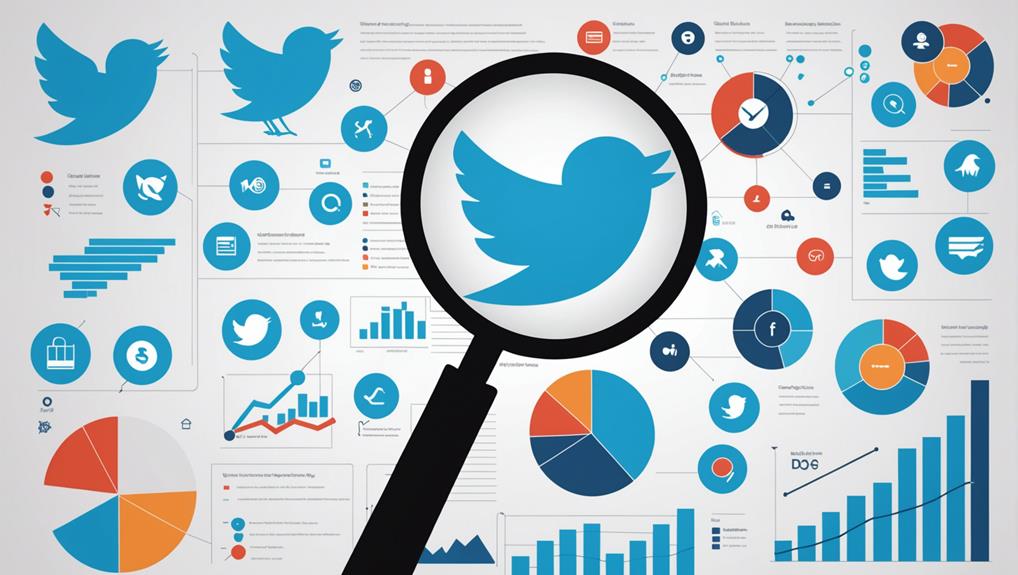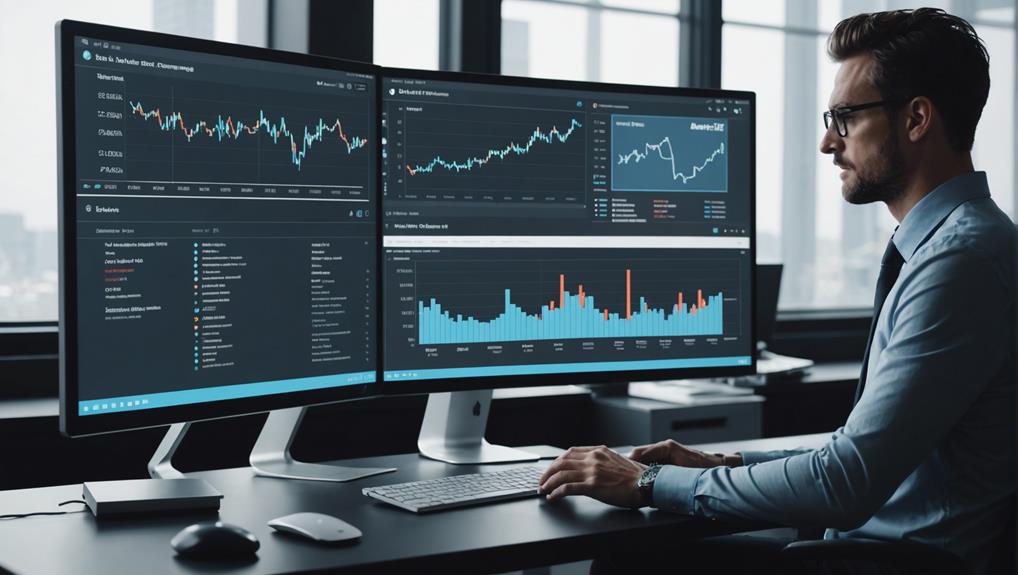Mastering competitive analysis through Twitter metrics involves scrutinizing engagement rates, follower growth, and tweet impressions to refine social media strategies. Analyzing these data points helps identify successful competitor tactics and audience demographics, enabling brands to tailor their approach for improved market positioning. Tools like Twitter Analytics and third-party platforms offer valuable insights into competitors’ performance, facilitating effective benchmarking and content strategy adaptation. By consistently reviewing engagement metrics and aligning posting schedules with industry standards, brands can enhance visibility and effectiveness. Explore how strategic data utilization leads to potent competitive advantages and impactful audience engagements.
Key Takeaways
- Analyze engagement metrics to understand audience interaction and content effectiveness compared to competitors.
- Monitor follower growth to assess the success of marketing strategies and identify new market segments.
- Evaluate tweet impressions to gauge reach and refine content strategies for broader visibility.
- Utilize hashtag performance analysis to align content with trending topics and improve audience resonance.
- Leverage tools like Twitter Analytics and Sprout Social for detailed competitor benchmarking and performance insights.
Understanding Competitive Analysis
Conducting a thorough competitive analysis on Twitter is essential for brands aiming to enhance their market positioning and improve audience engagement strategies. By analyzing Twitter competitor data, companies can gain valuable insights into various performance metrics such as engagement rates and follower growth. Understanding these metrics helps formulate a robust content strategy that aligns with current social media marketing trends.
Reviewing the engagement tactics of 5-7 active competitors reveals effective practices that can be adapted to improve a brand’s own Twitter presence. These tactics often include identifying the types of content that resonate with audiences and the best posting schedules that maximize visibility and interaction. By observing these patterns, marketers can better tailor their strategies to drive audience engagement.
Furthermore, examining competitors’ audience demographics provides opportunities to identify untapped market segments. This analysis allows brands to refine their content strategy, ensuring it caters to diverse audience preferences.
Regular Twitter competitor analysis not only helps in setting realistic KPIs but also provides benchmarks for evaluating a brand’s performance relative to industry standards. Ultimately, such strategic insights are critical in adjusting marketing approaches to stay ahead of competition and enhance overall social media marketing effectiveness.
Key Twitter Metrics
A thorough understanding of key Twitter metrics is essential for developing a data-driven social media strategy that enhances brand visibility and engagement.
Engagement rate stands as a vital indicator, calculated by dividing total interactions by the number of posts and followers. This percentage reveals content’s ability to resonate with the audience, providing insights into what captures their interest.
Meanwhile, follower growth rate gauges the expansion of a brand’s audience over time, reflecting the success of marketing initiatives and the brand’s allure to potential followers.
Tweet impressions offer a quantifiable measure of how often a tweet is displayed, serving as proof of the reach and visibility of shared content. This metric, combined with click-through rates, is pivotal for evaluating the effectiveness of tweets containing links. The CTR is determined by dividing link clicks by total impressions, offering a clear view of how engaging the shared content is in driving traffic.
Furthermore, hashtag performance analysis allows marketers to understand the engagement and reach of specific hashtags, aiding in identifying trending topics and refining content strategies.
In the competitive landscape, these metrics provide invaluable insights into Twitter competitors, enabling brands to craft informed and strategic social media strategies.
Analyzing Competitor Performance
To systematically analyze competitor performance on Twitter, one must prioritize evaluating engagement metrics, which reveal the level of audience interaction and content resonance.
Monitoring follower growth provides critical insights into the effectiveness of competitors’ strategies in expanding their reach and attracting new followers.
Additionally, evaluating competitors’ content strategies through the analysis of tweet impressions, content types, and posting frequencies allows for the identification of successful formats and schedules that maximize engagement and visibility.
Evaluating Engagement Metrics
Leveraging data-driven insights, reviewing engagement metrics on Twitter provides a strategic advantage in understanding competitor performance. By analyzing engagement through Twitter Analytics, businesses can gauge how effectively competitors connect with their audience, shaping a robust content strategy. Metrics such as likes, retweets, and replies are pivotal in evaluating the resonance of competitors’ posts.
The engagement rate, a key indicator, is calculated by dividing total interactions by the number of followers and tweets. This percentage reveals the level of active involvement and affinity the audience has with competitors’ content.
In addition, monitoring the follower growth rate offers insights into brand popularity trends, serving as a benchmark against industry standards. While engagement metrics reflect real-time interaction, they also highlight the sustainability of competitors’ engagement tactics over time.
Additionally, examining click-through rates (CTR) on shared links provides a window into the effectiveness of competitors’ calls to action and content relevance. This analysis can inform strategic adjustments to drive traffic to websites or landing pages.
Furthermore, reviewing hashtag performance reveals trending topics and audience interests, enabling the crafting of content that resonates deeply with target demographics, ultimately enhancing overall engagement.
Monitoring Follower Growth
Understanding competitor performance through the lens of follower growth is essential for crafting effective social media strategies. Monitoring follower growth entails observing the rate at which competitors gain new followers, providing marketers with a benchmark for successful strategies. Key metrics, such as the percentage increase in competitors’ followers, offer insights into the effectiveness of their campaigns and content in engaging and expanding their audience.
Utilizing tools like Twitter Analytics and platforms such as Sprout Social allows for detailed analysis of follower growth trends and engagement rates, facilitating direct comparisons with competitors’ Twitter performance. Analyzing the timing of spikes in follower growth can reveal ideal posting times and content types that resonate most with audiences, consequently informing strategic content scheduling.
Additionally, gaining insights into competitors’ follower demographics and engagement patterns can uncover underserved potential audience segments. This presents opportunities for targeted marketing efforts that capitalize on gaps in the market. By systematically evaluating these aspects, businesses can refine their own strategies, ensuring that they not only track but also surpass competitors in capturing and retaining audience attention on Twitter.
Ultimately, this data-driven approach to monitoring follower growth is invaluable for enhancing competitive positioning in the digital landscape.
Assessing Content Strategies
Strategic insight into competitor content strategies on Twitter can substantially refine a brand’s own approach to social media marketing. By analyzing competitors’ performance, brands can extract valuable lessons on optimizing engagement rates, identifying effective types of content, and leveraging the frequency and timing of posts. Monitoring key metrics such as engagement rates, which for average accounts range from 0.5% to 3%, allows brands to understand how well content resonates with audiences. Significantly, video content tends to generate 10 times more engagement compared to text or image posts.
Evaluating the frequency and timing of competitors’ tweets is essential, as tweets posted during peak hours, typically between 12 PM and 3 PM, garner higher interactions. Additionally, the strategic use of hashtags is pivotal; tweets with 1-2 relevant hashtags can experience a 21% increase in engagement.
Here is a summary to evoke strategic thinking:
| Metric | Insight |
|---|---|
| Engagement Rates | 0.5% – 3% typical; aim for high rates |
| Types of Content | Videos generate 10x more engagement |
| Frequency & Timing | Peak hours: 12 PM – 3 PM |
| Hashtags | 21% increase with 1-2 hashtags |
| Audience Interactions | Analyze replies and retweets |
Tools for Data Collection
In the domain of competitive analysis, leveraging essential analytics platforms such as Twitter Analytics, Hootsuite, and Sprout Social is vital for extracting actionable insights.
These tools not only facilitate the tracking of key metrics like engagement rates and follower demographics but also enable strategic benchmarking against competitors.
Essential Analytics Platforms
For businesses seeking to harness the full potential of Twitter as a marketing platform, leveraging robust analytics tools is essential. Twitter Analytics, a free and thorough tool, offers invaluable insights into engagement metrics, follower demographics, and tweet impressions, empowering users to refine their Twitter marketing strategy effectively.
By understanding these metrics, businesses can optimize content performance analysis and adapt to their audience segments‘ preferences.
Third-party tools such as Hootsuite and Sprout Social enhance these capabilities with advanced social media analytics, including competitor benchmarking. These platforms provide extensive data visualization, enabling marketers to strategically refine their content and engagement tactics.
Competitor benchmarking allows businesses to gauge their performance against industry counterparts, identifying strengths and areas for improvement.
Additionally, Followerwonk focuses on Twitter bio search and analytics, delivering insights into competitor follower demographics and engagement patterns. This data aids in identifying potential audience segments and improving targeting strategies.
BuzzSumo further complements these tools by analyzing content performance and engagement metrics, helping marketers discern which topics and formats resonate with their audience.
Lastly, Socialbakers offers comparative analysis tools for benchmarking against competitors, facilitating a more strategic approach to Twitter marketing.
Key Metrics Identification
Understanding key metrics is fundamental for businesses aiming to leverage Twitter as a competitive analysis tool. Twitter engagement, follower count, and content formats are vital indicators of a brand’s performance and can be effectively tracked using various Analytics tools.
Twitter Analytics offers native insights, providing data on engagement rates, impressions, and follower growth, all of which are key metrics that offer a window into competitors’ Twitter strategies.
To further enhance data collection, third-party platforms like Hootsuite and Sprout Social are invaluable. These tools allow businesses to track competitors’ Twitter performance, offering a thorough view of engagement metrics and strategic content deployment.
Followerwonk, with its focus on Twitter bio search and analytics, assists in dissecting competitor audience demographics and engagement patterns, offering strategic insights into audience preferences.
BuzzSumo stands out by allowing users to analyze content performance and pinpoint trending topics, thereby identifying successful strategies employed by competitors.
Additionally, Socialbakers provides a benchmarking service, facilitating comparative analysis that helps businesses understand their market positioning.
Deploying these tools strategically enables businesses to perform a robust Twitter engagement analysis, ultimately helping them refine their social media strategies and gain competitive advantage.
Monitoring Audience Engagement
Effective monitoring of audience engagement on Twitter hinges on a thorough analysis of key metrics such as likes, retweets, replies, and mentions. These metrics collectively provide a wide-ranging view of how well content resonates with followers. Calculating the engagement rate—total interactions divided by total followers, expressed as a percentage—is essential in evaluating the effectiveness of tweets in capturing audience interest.
Analyzing timing is equally important, as it reveals peak engagement periods, enabling marketers to optimize posting schedules. Utilizing Twitter Analytics or third-party platforms like Hootsuite offers detailed insights into audience engagement patterns. These tools help identify which content types, such as images, videos, or polls, generate the most interaction, thereby informing content strategies.
Moreover, tracking hashtag performance alongside engagement metrics uncovers trending topics and audience interests, guiding future content strategies for enhanced engagement. This strategic insight is invaluable for maintaining a competitive edge in the dynamic social media landscape.
| Metric | Insight Gained |
|---|---|
| Engagement Rate | Assesses tweet effectiveness |
| Timing Analysis | Identifies peak interaction periods |
| Content Type Performance | Determines most engaging content formats |
| Hashtag Performance | Uncovers trending topics and audience interests |
Employing these strategies provides a robust framework for mastering competitive analysis through Twitter metrics.
Developing Effective Strategies
To craft successful strategies on Twitter, leveraging data-driven insights from competitive analysis is indispensable. By analyzing your Twitter landscape, you can tailor an effective Twitter strategy that enhances your brand’s visibility and engagement.
Begin with a thorough competitor analysis to identify the engagement rates of various content types, such as text, media, or curated posts, to determine what resonates most with audiences. This insight is pivotal in optimizing your content strategy to boost interaction and follower loyalty.
Align your posting schedule with competitor activity metrics. Observe when they achieve peak engagement and adjust your timing to maximize reach and interaction. This strategic alignment guarantees your tweets are visible when your audience is most active.
Additionally, analyzing competitor hashtag performance can unearth trending industry topics, allowing for timely content creation that aligns with audience interests.
Experimentation is key. Test different content formats, such as threads versus single tweets, to determine which yields better results. Monitoring competitors’ audience demographics can also reveal untapped segments, enabling refined targeting in your marketing efforts.
Leveraging Insights for Growth
Analyzing competitor metrics not only helps in crafting effective strategies but also serves as a foundation for leveraging insights that propel growth. By understanding competitors on Twitter, brands can dissect engagement rates and follower growth, disclosing content strategies that captivate audiences. These insights can be adapted to bolster one’s Twitter presence, guaranteeing that content resonates with the target demographic.
Incorporating tools like Twitter Analytics is essential for tracking key metrics such as tweet impressions and click-through rates. This data-driven approach facilitates the enhancement of content for improved audience engagement.
Additionally, by monitoring hashtag performance across competitors, brands can identify trending topics and insert themselves into pertinent conversations, thereby amplifying their visibility and reach.
A strategic review of competitors’ posting schedules and content types reveals ideal timings for engagement. This allows brands to fine-tune their own schedules for maximum impact.
Furthermore, conducting sentiment analysis on competitors’ mentions provides a deeper understanding of public perception and audience preferences. This information is invaluable for shaping future marketing strategies and product development.
Ultimately, leveraging these insights guarantees that brands remain agile and responsive in the dynamic landscape of social media marketing.
Setting Performance Benchmarks
In the competitive landscape of social media, establishing performance benchmarks is essential for brands aiming to enhance their Twitter presence. By conducting a thorough competitor analysis, businesses can gain valuable insights into ideal engagement rates, follower growth, and tweet impressions.
For instance, engagement rates typically range from 0.5% to 2% across various industries. By benchmarking against these figures, brands can ascertain their relative standing and adjust their content strategy accordingly to achieve rates that may surpass the 2% mark seen in top-performing accounts.
Monitoring follower growth is equally important. A competitor experiencing a 5% monthly increase could indicate successful strategies worth adopting. Therefore, setting benchmarks based on these insights can drive more targeted and effective growth efforts.
Moreover, tweet impressions serve as a significant metric, with a baseline goal of 1,000 impressions per tweet being a realistic target for ensuring visibility.
In addition, analyzing the posting cadence of successful competitors, which often averages 3-5 tweets per day, can guide brands in aligning their frequency with industry standards.
Frequently Asked Questions
How Can Twitter Metrics Influence Long-Term Business Strategies?
Twitter metrics can strategically inform long-term business strategies by analyzing audience engagement, content performance, and hashtag effectiveness, enabling insights into influencer impact, market positioning, competitor benchmarking, and campaign optimization, ultimately guiding data-driven decision-making for sustained growth.
What Role Does Sentiment Analysis Play in Competitive Analysis?
Sentiment analysis, by identifying sentiment trends, enhances competitive analysis through insights on brand perception and audience engagement. It aids in understanding competitor insights, crisis management, content effectiveness, and market positioning, thereby informing strategic business decisions.
How Often Should Twitter Analytics Be Reviewed for Optimal Results?
For ideal results, an Analytics Review Schedule with Real Time Monitoring should be implemented. Twitter Engagement Frequency and Audience Response Timing guide Ideal Reporting Intervals, ensuring Data Driven Decisions and effective Campaign Performance Tracking aligned with strategic objectives.
Can Twitter Metrics Predict Future Industry Trends?
Twitter metrics can aid in trend forecasting by analyzing audience engagement, content virality, and influencer impact. Insights into market sentiment, hashtag performance, and competitor benchmarking provide strategic predictions, enhancing understanding of future industry developments.
How Do Twitter Metrics Correlate With Overall Brand Reputation?
Twitter metrics such as engagement, follower growth, and content performance are essential indicators of brand reputation. Raised audience perception and brand trust can be influenced by influencer impact and effective crisis management, reflecting positively on overall brand standing.
Conclusion
Mastering competitive analysis through Twitter metrics necessitates a strategic approach that integrates thorough data collection, analysis of key performance indicators, and continuous monitoring of audience engagement. By leveraging insights from competitor performance and employing robust analytical tools, organizations can develop effective strategies that enhance growth and set performance benchmarks. A data-driven methodology guarantees that insights are actionable and aligned with market dynamics, thereby facilitating informed decision-making and fostering a competitive edge in the digital landscape.




